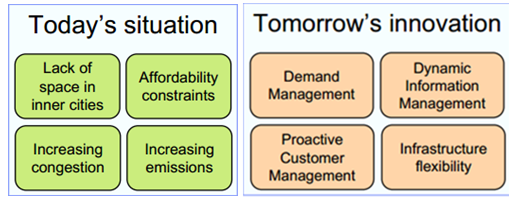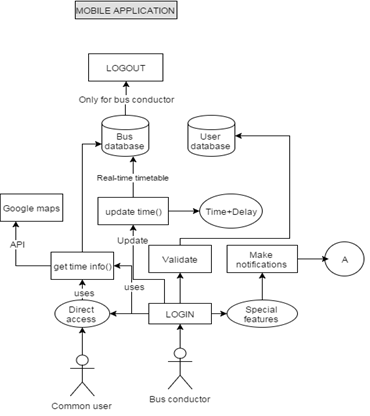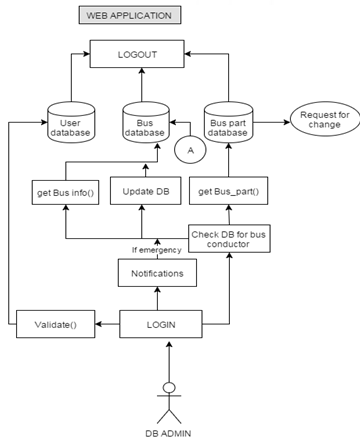Shriyansh Yadav, Rakesh Wadhwani, Avani Sheth, Gunjan Vacchani, Priya R. L.
Department of Computer Engineering, Vivekanand Education Society’s Institute of Technology, University of Mumbai
Correspondence to: Shriyansh Yadav, Department of Computer Engineering, Vivekanand Education Society’s Institute of Technology, University of Mumbai.
| Email: |  |
Copyright © 2015 Scientific & Academic Publishing. All Rights Reserved.
This work is licensed under the Creative Commons Attribution International License (CC BY).
http://creativecommons.org/licenses/by/4.0/

Abstract
In order to enrich the transportation system with improved level of intelligence and information, the basic function of Intelligent Transportation System (ITS) was analyzed. Superimposing it with the Internet of Things functionality, the intelligent recognition, location tracking and monitoring of buses through exchanging information and communication can be made possible. This paper proposes the plan about the use of typical notions and interaction modes of social networking can be extended to ITS and the networks of Things. It provides a Social Internet of Things (SIoT) platform in order to achieve objective of increasing the availability, reliability and efficiency of the BEST bus services in Mumbai using the social monitoring and analysis of the traffic data.
Keywords:
Internet of Things, ITS, Social monitoring and analysis
Cite this paper: Shriyansh Yadav, Rakesh Wadhwani, Avani Sheth, Gunjan Vacchani, Priya R. L., Social Monitoring and Analysis of BEST Bus Services Using Internet of Things (IoT), International Journal of Information Science, Vol. 5 No. 2, 2015, pp. 25-29. doi: 10.5923/j.ijis.20150502.01.
1. Introduction
In a city like Mumbai, traffic infrastructures are already operating at near or full capacity. Therefore, it is crucial to find ways to optimize the performance of existing transportation assets. Additionally, due to the dissatisfaction caused by poor schedule adherence, commuters find the lack of advisories about anticipated vehicle delays even more frustrating.The objective of developing an enhanced working model of BEST bus services is based on the lines of Intelligent Transportation System (ITS), which aims at achieving an intelligent, informative, socially integrated management and control system by applying the advanced technology of sensor, network, information and computer processing to the current model. The proposed model considers every bus in the system as a THING and thus, the Internet of Things concept is used to support the process of data storage and information gathering. The Internet of Things [2] is a network which connects different kinds of devices. IoT can connect the message instruction and sensor equipments to implement the exchange and sharing of information and eventually we can get a simultaneous and intelligentized management network. Internet of Things (loT) concepts are applied for connecting people with smartphones via Application Programming Interfaces (APIs) of SNS services [4] (Proposed mobile application) in order to provide richer information to travelers. The Internet of things has powerful data acquisition function, and it can provide more comprehensive traffic data for the ITS [3]. Real time, accurate and comprehensive traffic data are the basic guarantee of efficient operation for the ITS [8]. | Figure 1. Need of the proposed plan |
The proposed plan aims to offer predictions about vehicle arrival times at future destinations adding significant value to transit operations that are struggling to address these pain points. It offers to operators the vital decision support to implement measures, such as instructing drivers to catch up or change routes, to bring vehicles back on schedule. It also makes it possible to share trustworthy information with commuters about the arrival of the next vehicle, leading to higher customer satisfaction.The core idea of the proposed plan, the Social Internet of Things [1] platform, leads to the discussion of two main components (A) Social Monitoring (B) Social Analysis. The Social Monitoring and Social Analysis components improve the mechanisms used to establish social links that facilitate cooperation and enable selective sharing of knowledge and IoT-services through recommendation services. The Social Monitoring (SM) component contains all the main tools and techniques that are used for the monitoring of the social properties of the BEST bus services. Its main objective is to collect, aggregate and distribute monitoring data (events like number of passengers, routes selected, adherence to proper conduct, profits and operational maintenance costs of each THING i.e. bus) across the decision making components of the system. The events are generated by interactions in response to - directly or indirectly - user actions (e.g. registering a new component or a new route) or actions (requirements/needs sharing). The Social Monitoring “feeds” the information Registry and forwards its data to the Social Analysis component.The Social Analysis (SA) component, based on the information in the Social Monitoring component and taking advantage of Social Network Analysis (SNA) [1], is used for deciding models and patterns regarding the routes followed by them and the relations between them. These social properties and relations that will be extracted could be used by the THINGS of the project platform.
2. Related Work
Intelligent Transportation System (ITS) has already been implemented in various parts of the world. [10] explains the transportation industry, its concept and applications introduced, to analyze the advantages and disadvantages of developing the Internet of Things in Intelligent Transportation in China, the development progress and current situation of Intelligent Transportation System (ITS) in China and abroad, and the bases of the Internet of Things. ITS is very well implementable in [4] with the use of GPS, RFID, wireless communication. [3] explains the working of ITS along with IoT. The concept model for an intelligent transport system using the Internet of Things architectural model is explained in [11]. It shows both the motivation and application of this model within the context of the Jamaican transportation environment. The only different technology to be incorporated is explained in [1]. And the designing and simulation of the applications and databases can be done using the earlier works in [5], [6], [7].
3. Methodology
The work proposes Bus data monitoring and analysis for BEST services and provide the commuters a proper bus time-table depending upon the existing/real-time data and also helps to keep a track record of the maintenance of the components. Interactions of the bus traffic management can be extended to the networks of Things, which will provide a Social Internet of Things (SIoT) platform. This will lead to a highly reliable and dependable service provision by BEST to the end commuters.Fig 2, explains Model-View-Controller (MVC) model of the proposed system. In MVC structure, model consists of databases involved with the object information they address. The Controller includes all the functions responsible for authorizing, authenticating and providing the required information to the user through the use of IoT (sensors, GPS, RFID). The View layer consists of user interfaces as well as the results displayed to the end-users. Depending upon the architecture, the proposed model can be divided into three different modules: | Figure 2. Model-View-Controller (MVC) model of Social Monitoring and Social Analysis of BEST Bus services using IoT |
(A) Database Development:The development of the database involves designing the database schema of two independent databases. Firstly, the database includes static Bus information that includes Bus Station data, Bus time-table, Bus routes that would form the basic database, supported by the dynamic database to be used for displaying the timings in the applications as per real-time data.A secondary database that stores the complete information of each THING (Bus) involved in the system. It would include the information about current condition of the bus parts and its servicing needs. It also stores information about the assigned bus driver and conductor. This would help us keeping a track of condition of THINGS (Bus) and thus provide the commuters with a safe and comfortable journey experience. (B) GUI Applications:A web application exclusively for server side armed with features like entries related to inclusion/exclusion of buses or change of bus routes/time-tables (i.e. changes in planning of stops or routes permanently), data about the employees and THINGS (bus), display of IoT provided information (GPS, RFID) will be designed using HTML5/HTML, CSS3/CSS, JavaScript and web-framework. An Android mobile application with a set of complete user-friendly features supporting Google API, Notifications, Bus time-table Display, will be designed using Android Studio. The mobile application will have the features to display the bus-schedule (based on bus number, specified route), Google Maps API (for those who wish to view the route on a real-time data), and notify (to provide updates/notification to other users). It will have different login structure for both conductors and commuters for avoiding any discrepancies later.(C) Internet of Things implementation:The most important and essential feature of the Internet of things is the connection among every THING (Bus) involved in the system. A large number of traffic participant, whether it is a person or vehicle, even the road relevant facilities information will quickly gather to the Internet of things. By the use of the Internet of Things, ITS can collect all kinds of traffic data on the road. The IoT requires complex interconnection between hardware, such as sensors and actuators, and software that works at the assembly level. It could be implemented as stated in [4] with the use of:(1) Global Positioning System:In our system, every THING (i.e. Bus) will be equipped with a device capable of sending its location and standard time of arrival at the stops to the database administrator. It could also be equipped with ECU (Electronic Control Unit) i.e. an on-board computer in order to make decision by getting inputs from sensors and CAN bus (Controller Area Network) i.e. a vehicle bus standard designed to allow micro-controllers and devices to communicate with each other within a vehicle without a host computer. This information can be shared among the THINGS through the mobile application by the DB admin along with the traffic updates in the form of notifications. We can thus record bus location, time, weather and others from the satellite and real-time-condition of the Bus journey.(2) RFID reader:Every bus needs to have radio frequency identification (RFID) readers. When the bus reaches the site, the RFID reader installed in the platform will detect it, and the situation will be sent to the concerned bus station monitoring center.(3) Wireless communication system:Sharing the received GPS and RFID data with the control center using Internet, and display it on the web application of monitoring center, to facilitate the management of real-time scheduling.Also, in order to incorporate Social Monitoring and Analysis, the data can also be obtained from the conductor through the mobile application and shared with others in the same network by using in-app feature of sharing notifications. A hybrid technique can be implemented incorporating the benefits of both IoT and this technique that would actually make the system more robust and reliable.The implementation of the proposed idea as shown in fig 3 is depended on the working of the database responsible for updating the time-table of the Bus Services, accessible to the users through the mobile application, according to the real-time traffic data and social data of the THINGS. Structural data is required for implementing the database features. Basically, the user gets to view the updated schedule of the buses everytime there is a delay of more than 5 minutes. In case of other situations as well as emergencies, the notifications received from conductor, the database admin (using the traffic details or location-tracking data, if any), and registered users will be useful for conveying the users the current frame of the bus-services. | Figure 3. Mobile Application Flow Diagram |
Apart from the primary database, for ensuring a smooth functioning of the Buses in the network, their maintenance and servicing data could be stored in a separate database. This will help in keeping track of the Bus condition as well as would majorly prevent inconvenience to passengers and road mishaps.As specified in fig 4, the web application will be used only by the database administrator for making more significant permanent updations in the database. | Figure 4. Web Application Flow Diagram |
The system will provide the user with a Bus-Schedule, when there is a delay in the services. This information can be updated using the data obtained. The user will get notifications regarding the services and traffic status through the Mobile Application. The entire efficacy control will be monitored and affected by the database administrator managing the database.
4. Conclusions
The designing of the proposed project is based on the Internet of Things and GPS, updating and restructuring the original bus information system efficiently. This helps to make the most important public transport system in the city to meet with modern society needs.To sum up, in this paper we go beyond the state of the art by:(1) Identifying and establishing social properties and relations between THINGS (Buses as well as its services) in such a way that the resulting network is effectively manageable. It is also reliable and dependable for the individuals. (2) To offer predictions about vehicle arrival times at future destinations adding a significant value to transit operations.(3) Studying social analysis metrics and properties i.e. identifying roles for the components (Buses as well as its services) and desired functionalities for System Analysis component. Further functionalities could be added to the system for improving future efficacy by planning and implementing sensors and devices to have Vehicle trip/route management, fuel efficiency management, proactive vehicle maintenance, vehicle utilization, real-time alerts, Vehicle condition management (brakes, gear ratio), vehicle operation (Load, speeding, idling), Real-time vehicle breakdown alerts, predictive maintenance alerts, Proactive failure tracking & alerting, parts planning, vehicle usage analysis in correlation to external factors (weather, road conditions). In this way, an increase in reliability of the bus services would facilitate increase in number of commuters and the use of public transport thereby solving a lot of other problems like transportation congestion, environmental pollution and traffic security.
References
| [1] | Orfefs Voutyras, Panagiotis B, Spyridon Gogouvitis, Dimosthenis Kyriazis, Theodora Varvarigou, (2015), “Social Monitoring and Social Analysis in Internet of Things Virtual Networks”, 18th International Conference on Intelligence in Next Generation Networks. |
| [2] | Wang Baoyun, (2009), “The research summary of the Internet of Things”, [J] Journal of electronic measurement and instrument, (12):1-7. |
| [3] | Liu Chunli [P] Department of Computer Engineering Cang Zhou Normal College Cang Zhou Hebei, “Intelligent Transportation based on the Internet of Things”. |
| [4] | Zhu Yongjun, Zhu Xueli, Zhu Shuxian, Guoshenghui, “Intelligent Transportation System Based on Internet of Things”. |
| [5] | Yang Yu School of Remote Sensing and Information Engineering Wuhan University Wuhan, China, Bin Li Department of Geography Central Michigan University Mount Pleasant, MI, United States, “Real-time Traffic Data Management for Dynamic Vehicle Navigation System”. |
| [6] | J. Lopes, J. Bento, E. Huang, C. Antoniou, M. Ben-Akiva, Instituto Superior Técnico, Brisa Auto-Estradas de Portugal jlopes, Intelligent Transportation System Laboratory MIT, Cambridge MA, USA,(2010), “Traffic and Mobility Data Collection for Real - Time Applications”, 13th International IEEE Annual Conference on Intelligent Transportation Systems Madeira Island, Portugal, September 19-22, 2010. |
| [7] | Jianjun Yu, Fuchun Jiang, Tongyu Zhu, China, (2013), “RTIC-C: A Big Data System for Massive Traffic Information Mining”, International Conference on Cloud Computing and Big Data. |
| [8] | Yi FU, Zhiheng LI, Kezhu SONG, Zhigang QIU, Xuhui MA, (2006), Integrated Traffic Management Platform Design Based on GIS-T1”, 6th International Conference on ITS Telecommunications Proceedings |
| [9] | Atzori, L., Iera, A. and Morabito, G, (2014), “From ‘Smart Objects’ to ‘Social Objects’: The Next Evolutionary Step of the Internet of Things”, IEEE Communication Magazine, Networks, vol. 52, no. 1, 2014, pp. 97–105. |
| [10] | Deng Ai-Min, TianFeng, Mao Lang, CaiJia, “Comparative Study on the Development of the Internet of Things in Intelligent Transportation between China and abroad”, 2011, School of Business Administration Hunan University Changsha, Hunan, China. |
| [11] | Charles Deans, School of Computing and Information Technology, University of Technology, Jamaica, “The Design of an Intelligent Urban Transportation System in Jamaica based on the Internet of Things”, Proceedings of the IEEE Southeast Con 2015 - Fort Lauderdale, Florida. |
| [12] | Website URL [http://www.slideshare.net/] |
| [13] | Website URL [http://www.social-iot.org] |
| [14] | Website URL [http://www.theinternetofthings.eu/] |







 Abstract
Abstract Reference
Reference Full-Text PDF
Full-Text PDF Full-text HTML
Full-text HTML